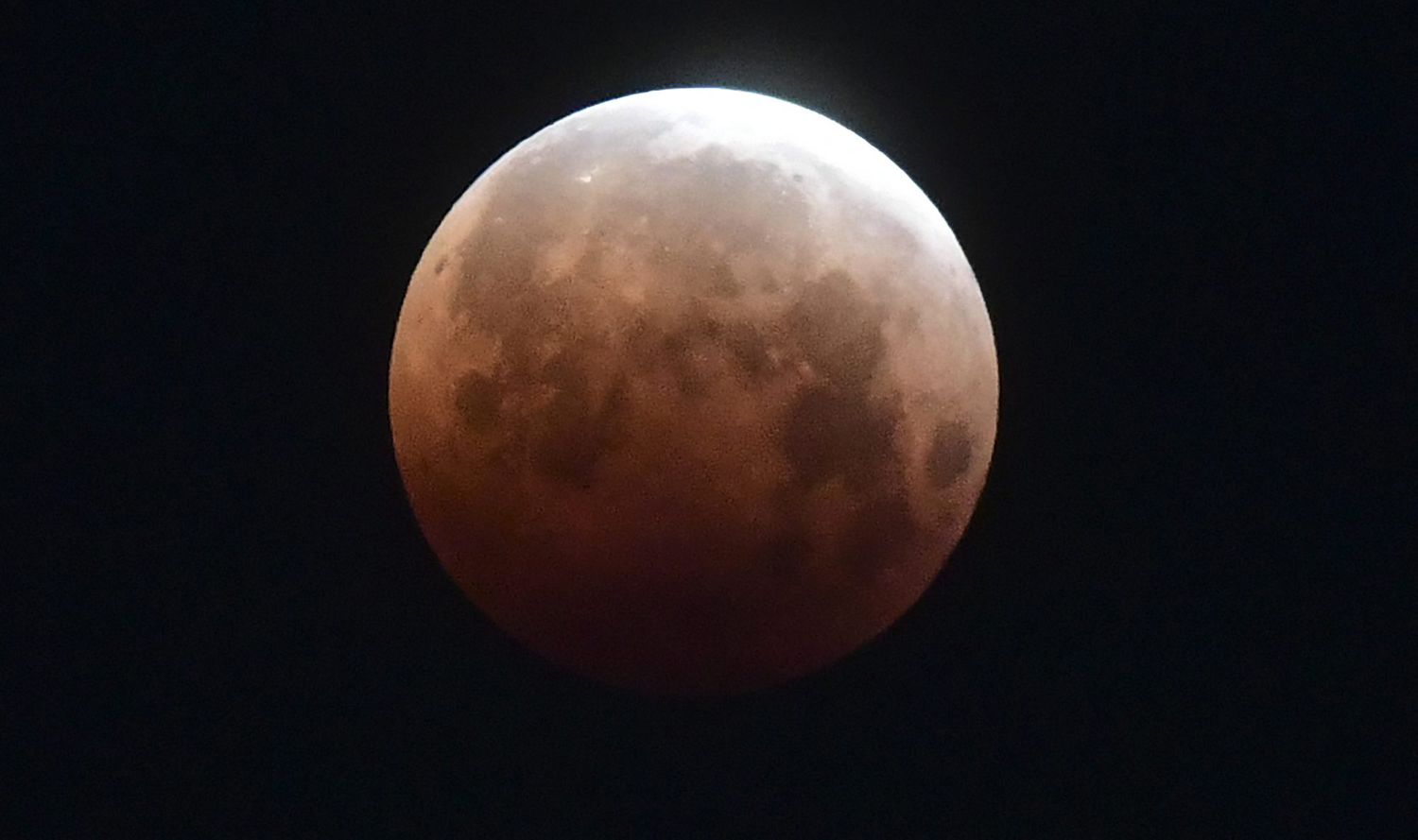When Does The Total Flowering Blood Moon Eclipse Begin?
A super flowering blood moon will soon be visible in the night sky, and it will be one of the most breathtaking spectacles that our planet has to offer. The Earth will move in between the Sun and the Moon during the only total lunar eclipse that will occur this year.
Author:Evelyn AdamsReviewer:Mia ThompsonJan 04, 20249.4K Shares236.5K Views

A super flowering blood moonwill soon be visible in the night sky, and it will be one of the most breathtaking spectacles that our planet has to offer. The Earth will move in between the Sun and the Moon during the only total lunar eclipsethat will occur this year.
As the Moon moves deeper into Earth's shadow, it will gradually become darker before taking on a rusty red color. Additionally, it will be referred to as a super floral blood moon. A full moon that occurs in May and corresponds with the blooming of spring flowers is commonly referred to as a flower moon in the Northern Hemisphere. During the total eclipse, the only sunlight that will reach the Moon will be that which has traveled through the atmosphere of Earth.
Why Is It Called A Super Flower Moon?
Isn't it a quite memorable name? To get a better grasp on it, we need to dissect it first. To begin, let's talk about the 'Flower' part: Throughout history, many societies have given various names to full moons that occur across the lunar calendar. Native American cultures are responsible for the development of a significant portion of the common nicknames for the moon that are used today.
The month of May's full moon is known as the Flower Moon in many cultures. This is because of the profusion of flowers that appears at this time of year when spring is finally getting its act together. There are also other names for this moon, such as the milk moon, the hare moon, and the corn-sowing moon.
The word "super" in the phrase "supermoon" indicates that the upcoming full moon will have the potential to appear up to 14% larger and 30% brighter than usual. This phenomenon is known as a "supermoon." Because of this, the full moon that will occur in May is referred to as a Super Flower Moon because it will also be a supermoon.
The Super Flower Blood Moon Stages
The timetable that was just presented provides details on the local environment for each of the eight different time zones. If there are dashes in the graph, it means that the moon has not yet risen over the horizon.
Following is a rundown of the phases of the blood moon complete lunar eclipse, as well as an explanation of what kinds of things you might observe during each one.
The Moon Enters The Penumbral Shadow
There is a darker region, known as the umbra, at the center of the Earth's shadow cone, which is bordered by a lighter region, known as the penumbra. The fainter outer part of the shadow cast by the earth is called the penumbra.
Even if the eclipse is beginning at this very minute, you won't be able to notice anything out of the ordinary happening to the moon just yet. When the moon is completely submerged in the penumbra of Earth's shadow, at the point where the penumbra has reached around 70 percent of the moon's disk, the penumbral shadow of Earth is no longer visible.
The full moon will appear to shine normally for the next forty minutes, but with each passing minute, it will move further and deeper into the outer shadow cast by Earth. This will continue for around another forty minutes.
Earth's Penumbral Shadow Appears
At this point, the moon has moved into the penumbra a sufficient distance for it to become visible on the disk of the moon. When you gaze at the moon, you should start looking for a very light shading to appear on the left side of the moon.
As the minutes go by, this will get progressively more obvious, as the shading will look to expand and grow more profound. The penumbra should become visible as an evident smudge or tarnishing on the moon's left part just before the moon starts to enter Earth's dense umbral shadow.
The Moon Enters Earth's Umbral Shadow
Now, the moon is beginning to move into the dark core shadow cast by Earth, which is known as the umbra. On the moon's lower left (southeastern) limb, there is the beginning of the formation of a small, dark scallop.
The partial phases of the eclipse begin, at this point, the pace picks up and the difference becomes more pronounced. The penumbra is substantially lighter in color than the umbra, which also has more angular edges.
The passage of time gives the impression that the black shadow is gradually moving across the moon's surface. At first glance, the moon's limb can appear to disappear entirely after it enters the umbra.
But much later, when it creeps in deeper, you will most likely observe the moon shining softly orange, red, or brown as it moves in closer. Aristotle, who lived in the fourth century B.C., was able to conclude the shape of the Earth by observing lunar eclipses.
He saw that the edge of the Earth's shadow that was projected on the moon was curved, which is apparent evidence that the Earth is spherical (or, more accurately, an oblate spheroid).
It is almost as if a dimmer switch were slowly being turned down on the surrounding countryside, and the deep shadows cast by a magnificent moonlit night were beginning to fade away.
The Moon Is 75% Covered
The portion of the moon's disk that is currently plunged in shadow should start to light up very faintly now that three-quarters of its disk has been eclipsed. This phenomenon is analogous to a piece of iron being heated to the point where it just begins to glow. It is now abundantly clear that the umbral shadow does not consist entirely of pitch darkness.
When viewed through binoculars or a telescope, the outer portion of the moon is typically bright enough to make out craters and seas on the moon. However, the core area is significantly darker, and there are periods when none of the surface characteristics can be made out.
The colors that can be seen in the umbra change dramatically from one eclipse to the next. Although reds and grays are typically the most prevalent colors, other hues, such as browns, blues, and others, can occasionally be seen.
Less Than Five Minutes To Totality
The contrast between the remaining pale-yellow sliver and the ruddy-brown coloration spread over the rest of the moon's disk may produce a beautiful phenomenon sometimes called the Japanese lantern effect. This term was first coined by astrophotography Peter A. Leavens in the 1950s. It can occur several minutes before (and after) totality.
Total Flowering Blood Moon Eclipse Begins
The total eclipse of the moon begins when the very last of the moon's disk comes into contact with the umbra. It is unknown how the moon will look when the eclipse is at its entire phase. There are certain types of eclipses in which the sky turns such a pitch-black color that the moon is almost impossible to see.
During other types of eclipses, it may radiate a fiery orange glow. The sunlight is scattered and refracted around the edge of the Earth by our planet's atmosphere, which allows the moon to be visible at all during a total eclipse of the moon.
If an astronaut were to stand on the moon during the total eclipse, they would see a dark Earth surrounded by a beautiful crimson ring that was made up of all of the world's sunrises and sunsets. This would obscure their view of the sun.
The amount of dust in the atmosphere and the prevailing weather patterns throughout the world both play a role in determining how bright this ring appears around the Earth. If Earth's atmosphere is clear, then the lunar eclipse will be very visible. If a significant volcanic eruption occurred within the past few years and injected particles into the stratosphere, the eclipse would be exceedingly black.

Super Flower Blood Moon total lunar eclipse 2022 - views from across the world
Why Is A Supermoon Brighter Than A Normal Full Moon?
The point in the Moon's orbit at which it is closest to the Earth is referred to as the lunar perigee, while the point in the Moon's orbit at which it is furthest from the Earth is referred to as the lunar apogee.
The term "supermoon" refers to a full moon that takes place when the Moon is at its furthest distance from Earth. The actual size of the Moon will not change, but since it will be at its furthest distance from the Earth, it will seem up to 14% larger and 30% brighter than usual, thus it is highly recommended that you check it out.
How The Lunar Eclipse Will Affect Each Zodiac Sign
This may relate to the emphasis on the Venusian themes of love, money, and pleasure when the full moon rises on Venus's day. In astrology, Venus is regarded as a minor benefit, making it generally fortunate planetary energy to deal with. The lunation day's magical association may inspire a resolve to harness the Scorpionic darkness to create something lovely and strange. In the words of Julia Cameron, "Creativity, like human life itself, begins in darkness."
Although the full moon may produce additional aspects, none of the other transiting planets are in any close contact with this one. Although this may at first seem monotonous, it's crucial to keep in mind that this lunation also functions as an eclipse, thus the lack of other factors to take into account may help us to appreciate the ecliptic energy for what it is. Given this, it would be advisable to observe this lunation and maintain your distance from it.
This full moon, which occurs at the end of a six-month cycle, will have some element of uncertainty since eclipses are a signof significant and unexpected fated occurrences. Take notice of what occurs three days before and three days after the lunation in the spirit of this eclipse. Be willing to get rid of something that is no longer beneficial to you.
People Also Ask
What Kinds Of Meanings Do People From Different Civilizations Associate With The Flowering Blood Moon?
Across numerous cultures, the Flowering Blood Moon has been given a variety of meanings, but it is most commonly regarded as a metaphor for change, transformation, and the cyclical aspect of life.
What Kind Of Emotional Connection Does The Flowering Blood Moon Have With Astronomy?
The beauty of the Flowering Blood Moon is something that can be appreciated by people of many backgrounds, and it serves as a reminder of our common sense of awe and fascination with the cosmos.
How Does The Presence Of Light Pollution Affect One's Ability To Appreciate The Flowering Blood Moon?
Light pollution from metropolitan areas obscures natural darkness, limiting our capacity to properly appreciate celestial occurrences such as the Flowering Blood Moon, and highlighting the significance of keeping dark skies. Light pollution is a major contributor to global warming.
Conclusion
The Flowering Blood Moon is a one-of-a-kind and entrancing movement that stands out in the larger-than-life symphony that is the universe. Its brilliant red tone, which was achieved via the application of scientific principles, elicits feelings that are not bound by either time or culture.
When we look up at this spectacular view of the cosmos, we become a part of a cosmic story that has been unfolding for millennia. This story links us not just to our ancestors but also to future generations.
The Flowering Blood Moon, with its otherworldly charm, encourages us to raise our gazes to the heavens, consider where we are about the cosmos, and take pleasure in the wondrous sights that lie in wait for us in the night sky.

Evelyn Adams
Author
Evelyn Adams is a dedicated writer at Kansas Press, with a passion for exploring the mystical and uncovering hidden meanings.
Evelyn brings a wealth of knowledge and expertise to her insightful articles. Her work reflects a commitment to providing accurate information, thoughtful analyses, and engaging narratives that empower readers to delve into the mysteries of the universe.
Through her contributions, Evelyn aims to inspire curiosity, spark imagination, and foster a deeper understanding of the supernatural world.

Mia Thompson
Reviewer
Mia Thompson is a versatile writer at Kansas Press, delving into a range of topics including news, spiritual exploration, astrology, and numerology. With a passion for delivering insightful and informative content, Mia's articles provide readers with valuable perspectives and thought-provoking insights into these intriguing subjects.
She is dedicated to creating content that resonates with readers and fosters a deeper understanding of complex topics.
Latest Articles
Popular Articles

